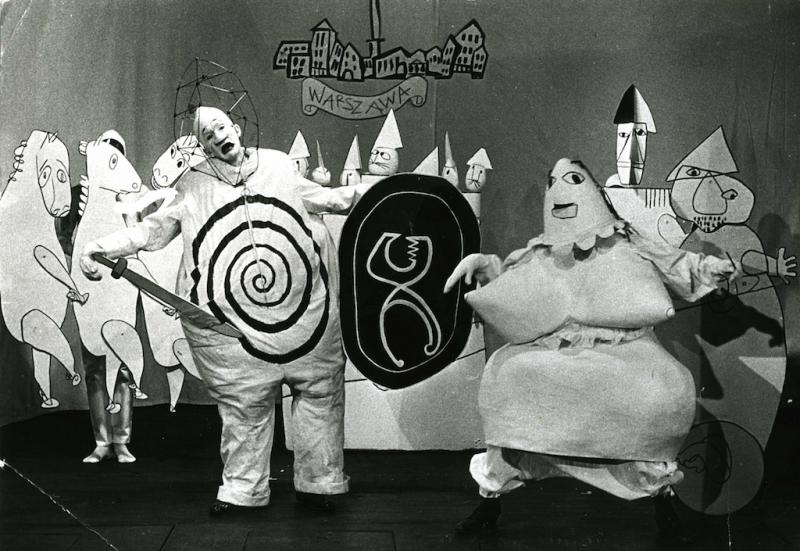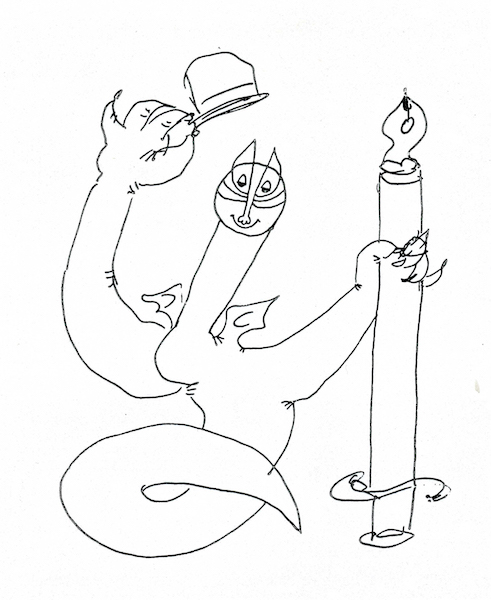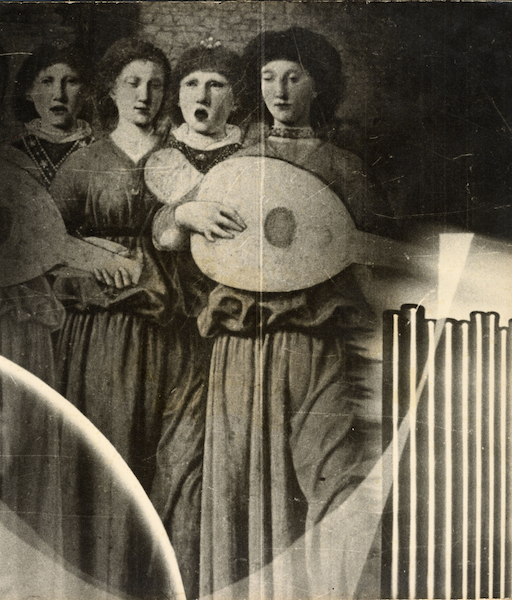Franciszka & Stefan Themerson, Camden Arts Centre | reviews, news & interviews
Franciszka & Stefan Themerson, Camden Arts Centre
Franciszka & Stefan Themerson, Camden Arts Centre
The Polish couple whose brilliant books have had a lasting influence on British design

Bertrand Russell’s History of the World is a charming little booklet that carries a chilling message: “Since Adam and Eve ate the apple, man has never refrained from any folly of which he is capable.” A line drawing shows Adam and Eve sharing a neatly sliced apple followed by a comic depiction of medieval warfare. Next comes “The End” printed opposite a photo of a mushroom cloud.
The booklet was published by the Gaberbocchus Press (colophon pictured below right), whose goal was to produce books that were “best lookers” rather than “best sellers”, in which the visuals are as important as the text. The lines of Apollinaire’s poem Il Pleut (It Rains), for instance, trickle down the page like incessant drizzle. The letters of Stefan Themerson’s poem Enjoy your bath... jump about like bubbles “bobbing up and down on the surface”, even though the poem warns that appearances can be deceptive: “all the waters of the world will harden/ into sharp cold crystals of hate sparkling with millions of enchanting rainbows”.
 Set up in 1948 by Franciszka and Stefan Themerson, the press was named after a spoof Latin translation of Lewis Carroll’s Jabberwocky; the opening phrase “T’was brillig” becomes “Hora aderat briligi”! Carroll’s darkly nonsensical humour appealed to the Themersons, who left Poland just before World War Two and came to London, via Paris.
Set up in 1948 by Franciszka and Stefan Themerson, the press was named after a spoof Latin translation of Lewis Carroll’s Jabberwocky; the opening phrase “T’was brillig” becomes “Hora aderat briligi”! Carroll’s darkly nonsensical humour appealed to the Themersons, who left Poland just before World War Two and came to London, via Paris.
The couple made a great team. Franciszka, who was also a painter, designed and illustrated these enchanting books, while Stefan wrote the poems, novels, essays and children’s stories which they published alongside the work of avant-garde authors like Guillaume Apollinaire and Kurt Schwitters. But their efforts weren’t much appreciated here in Britain. In 1962 the librarian of the Belsize Branch Library refused an offer of three books, including Stefan’s monograph on the German dadaist Schwitters, on the grounds that they would add little to the collection.
 Such indifference must have been especially disappointing since, in Warsaw, they’d been key members of the avant-garde, setting up the Polish Film-makers’ Co-op and making surrealist films inspired by French counterparts, such as René Clair’s Entr’acte, 1924. On show is The Adventure of a Good Citizen, 1937, in which people discover the freedom of walking backwards. Two men carry a wardrobe through the streets and into the woods; cue euphoric shots of light filtering through trees and Tommy Cooper-style gags based on reflections in the wardrobe mirror. The men are followed by a protest march whose members climb through the wardrobe and emerge into a utopian realm, where the furniture-movers fly like birds and play the flute like angels.
Such indifference must have been especially disappointing since, in Warsaw, they’d been key members of the avant-garde, setting up the Polish Film-makers’ Co-op and making surrealist films inspired by French counterparts, such as René Clair’s Entr’acte, 1924. On show is The Adventure of a Good Citizen, 1937, in which people discover the freedom of walking backwards. Two men carry a wardrobe through the streets and into the woods; cue euphoric shots of light filtering through trees and Tommy Cooper-style gags based on reflections in the wardrobe mirror. The men are followed by a protest march whose members climb through the wardrobe and emerge into a utopian realm, where the furniture-movers fly like birds and play the flute like angels.
In England, the Themersons continued to make films such as The Eye and the Ear, 1945, an exploration of the relationship between sound and vision. The angels in Piero della Francesca’s Nativity appear to sing (pictured above left), while in response to the music, abstract shapes representing the human voice and various instruments fill the screen with overlapping patterns reminiscent of art deco designs and the “thought forms” with which Rudolf Steiner illustrated similar concepts. The British censors banned Calling Mr Smith, 1943, in which sampled newsreel footage, photograms and stop-motion animation are used to create a harrowing account of the Nazi destruction of Polish culture.
 But it's the books that are the most memorable. They provided one of those eureka moments, when work you think you don’t know turns out to be extremely familiar. The case in point is Alfred Jarry’s absurdist play Ubu Roi, 1896. The Themersons published the first English translation of this comic classic, and Franciszka also produced the masks for a reading of the play at the Institute of Contemporary Art in 1952 and the costumes and sets for a 1964 production in Stockholm’s marionette theatre, which then toured the world. In 1969 she began a comic strip version in which the delicacy of her line makes the antics of the demonic anti-hero seem even more preposterous and arbitrary (pictured above).
But it's the books that are the most memorable. They provided one of those eureka moments, when work you think you don’t know turns out to be extremely familiar. The case in point is Alfred Jarry’s absurdist play Ubu Roi, 1896. The Themersons published the first English translation of this comic classic, and Franciszka also produced the masks for a reading of the play at the Institute of Contemporary Art in 1952 and the costumes and sets for a 1964 production in Stockholm’s marionette theatre, which then toured the world. In 1969 she began a comic strip version in which the delicacy of her line makes the antics of the demonic anti-hero seem even more preposterous and arbitrary (pictured above).
Having gone to Camden thinking I’d never heard of the Themersons, I came away realising that their beguiling imagery had long since infiltrated my very being, as well as having a huge influence on British design and illustration.
rating
Share this article
The future of Arts Journalism
You can stop theartsdesk.com closing!
We urgently need financing to survive. Our fundraising drive has thus far raised £49,000 but we need to reach £100,000 or we will be forced to close. Please contribute here: https://gofund.me/c3f6033d
And if you can forward this information to anyone who might assist, we’d be grateful.

Subscribe to theartsdesk.com
Thank you for continuing to read our work on theartsdesk.com. For unlimited access to every article in its entirety, including our archive of more than 15,000 pieces, we're asking for £5 per month or £40 per year. We feel it's a very good deal, and hope you do too.
To take a subscription now simply click here.
And if you're looking for that extra gift for a friend or family member, why not treat them to a theartsdesk.com gift subscription?
more Visual arts
 'We are bowled over!' Thank you for your messages of love and support
Much-appreciated words of commendation from readers and the cultural community
'We are bowled over!' Thank you for your messages of love and support
Much-appreciated words of commendation from readers and the cultural community
 Photo Oxford 2025 review - photography all over the town
At last, a UK festival that takes photography seriously
Photo Oxford 2025 review - photography all over the town
At last, a UK festival that takes photography seriously
![SEX MONEY RACE RELIGION [2016] by Gilbert and George. Installation shot of Gilbert & George 21ST CENTURY PICTURES Hayward Gallery](https://theartsdesk.com/sites/default/files/styles/thumbnail/public/mastimages/Gilbert%20%26%20George_%2021ST%20CENTURY%20PICTURES.%20SEX%20MONEY%20RACE%20RELIGION%20%5B2016%5D.%20Photo_%20Mark%20Blower.%20Courtesy%20of%20the%20Gilbert%20%26%20George%20and%20the%20Hayward%20Gallery._0.jpg?itok=7tVsLyR-) Gilbert & George, 21st Century Pictures, Hayward Gallery review - brash, bright and not so beautiful
The couple's coloured photomontages shout louder than ever, causing sensory overload
Gilbert & George, 21st Century Pictures, Hayward Gallery review - brash, bright and not so beautiful
The couple's coloured photomontages shout louder than ever, causing sensory overload
 Lee Miller, Tate Britain review - an extraordinary career that remains an enigma
Fashion photographer, artist or war reporter; will the real Lee Miller please step forward?
Lee Miller, Tate Britain review - an extraordinary career that remains an enigma
Fashion photographer, artist or war reporter; will the real Lee Miller please step forward?
 Kerry James Marshall: The Histories, Royal Academy review - a triumphant celebration of blackness
Room after room of glorious paintings
Kerry James Marshall: The Histories, Royal Academy review - a triumphant celebration of blackness
Room after room of glorious paintings
 Folkestone Triennial 2025 - landscape, seascape, art lovers' escape
Locally rooted festival brings home many but not all global concerns
Folkestone Triennial 2025 - landscape, seascape, art lovers' escape
Locally rooted festival brings home many but not all global concerns
 Sir Brian Clarke (1953-2025) - a personal tribute
Remembering an artist with a gift for the transcendent
Sir Brian Clarke (1953-2025) - a personal tribute
Remembering an artist with a gift for the transcendent
 Emily Kam Kngwarray, Tate Modern review - glimpses of another world
Pictures that are an affirmation of belonging
Emily Kam Kngwarray, Tate Modern review - glimpses of another world
Pictures that are an affirmation of belonging
 Kiefer / Van Gogh, Royal Academy review - a pairing of opposites
Small scale intensity meets large scale melodrama
Kiefer / Van Gogh, Royal Academy review - a pairing of opposites
Small scale intensity meets large scale melodrama
 Jenny Saville: The Anatomy of Painting, National Portrait Gallery review - a protégé losing her way
A brilliant painter in search of a worthwhile subject
Jenny Saville: The Anatomy of Painting, National Portrait Gallery review - a protégé losing her way
A brilliant painter in search of a worthwhile subject
 Abstract Erotic, Courtauld Gallery review - sculpture that is sensuous, funny and subversive
Testing the boundaries of good taste, and winning
Abstract Erotic, Courtauld Gallery review - sculpture that is sensuous, funny and subversive
Testing the boundaries of good taste, and winning
 Edward Burra, Tate Britain review - watercolour made mainstream
Social satire with a nasty bite
Edward Burra, Tate Britain review - watercolour made mainstream
Social satire with a nasty bite

Add comment